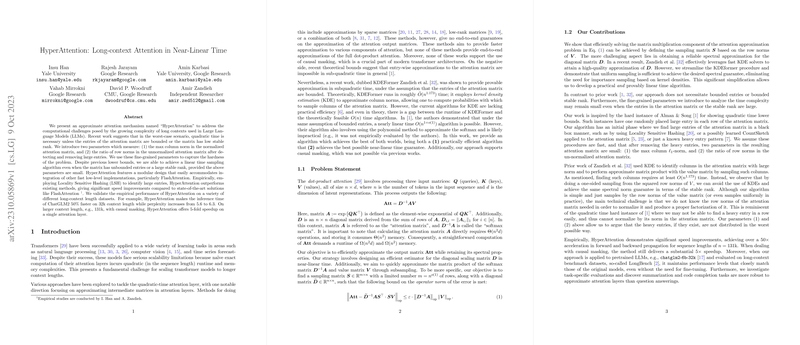HyperAttention: Long-context Attention in Near-Linear Time
The paper "HyperAttention: Long-context Attention in Near-Linear Time" presents an innovative approach to addressing the scalability issues prevalent in contemporary transformer architectures, particularly focusing on their computationally intensive attention mechanisms. Transformers, which are foundational to the success of LLMs, unfortunately incur quadratic time complexity in the computation of attention layers, presenting significant barriers to model scalability and efficiency with long contexts. The authors propose HyperAttention, an approximate attention mechanism, to mitigate these challenges by reducing the computation complexity to near-linear time under specific conditions.
Key Contributions
The primary contribution of this research is a modular design for HyperAttention, which leverages fine-grained parameters to subsample the attention matrix effectively, even when the matrix entries are unbounded or possess a high stable rank. The proposed algorithm introduces novel parameters to measure: (1) the maximum column norm in the normalized attention matrix, and (2) the ratio of row norms in the unnormalized attention matrix post-detection and removal of large entries. By ensuring these parameters are small, the algorithm achieves a near-linear time complexity, offering substantial improvements over existing methods.
HyperAttention employs Locality Sensitive Hashing (LSH) to detect large entries within the attention matrix efficiently, and the authors couple this with tailored sampling strategies. The approach is empirically validated to outperform existing methods, such as FlashAttention, by providing up to 50% faster inference times for models like ChatGLM2 on a 32k context length, while achieving up to a five-fold speedup for single attention layers with larger contexts, e.g., 131k, when utilizing causal masking.
Technical Framework
To achieve its objectives, HyperAttention integrates multiple core components:
- Attention Matrix Approximation: HyperAttention approximates the attention matrix by detecting large values through LSH and sampling according to row norms, ensuring effective modularity and adaptability.
- Causal Masking Support: Unlike many prior works, HyperAttention supports causal masking, critical for maintaining the autoregressive nature of LLMs.
- Spectral Guarantee: The algorithm provides a spectral guarantee on the approximation, employing sufficient conditions to ensure efficient sampling and computation.
- Implementation Efficiency: The architecture facilitates integration with existing solutions like FlashAttention, allowing straightforward adaptations for scale and speed.
Empirical Evaluation
The authors conducted comprehensive empirical studies demonstrating the algorithm's superior performance in various contexts. With practical experiments performed on LongBench datasets with ChatGLM2 and phi models, they show that HyperAttention maintains competitive accuracy with significantly reduced computational demands. Furthermore, the speed advantages provided by HyperAttention scale with longer input sequences, indicating robust performance suitable for modern use cases in natural language processing.
Theoretical and Practical Implications
Theoretically, HyperAttention challenges existing bounds by providing a framework that circumvents prior lower bounds for sub-quadratic time computations, bringing near-linear time complexities into practical deployment for LLMs. This breakthrough opens possibilities for more extensive and efficient handling of longer contextual information, which is critical for expanding the capabilities of transformer models.
Practically, HyperAttention has the potential to transform how large-scale models are designed and deployed, particularly where resource constraints or memory limits are significant considerations. By accelerating attention computations, HyperAttention can facilitate more rapid iterations and enable deployment scenarios previously hampered by time and memory requirements.
Future Directions
While HyperAttention represents a significant advancement in efficient attention computation, the paper leaves several future avenues open for exploration. Further research could consider optimizing the balance between approximation accuracy and computational gains and expanding the application scope beyond text-based models into other domains such as computer vision or multi-modal processing. There remains potential for integrating adaptive techniques or optimization strategies to enhance robustness across diverse input distributions, improving adaptability and customization for specific tasks or datasets.
In summary, the work on HyperAttention contributes a meaningful step towards more efficient, scalable attention mechanisms in large-scale transformer models, providing both theoretical insights and practical solutions to ongoing computational challenges in LLM deployments.
